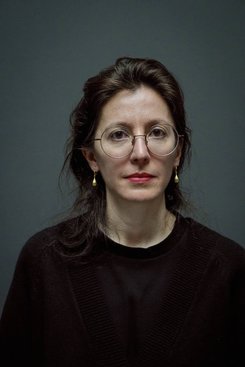

- Study programme Digitale Medien, Freie Kunst, Integriertes Design
- Email asli.serbest@hfk-bremen.de
- Website http://aslimona.xyz
Vita
Asli Serbest works in collaborations across spatial, image, sound, and text practices. Her processed-based projects evolve into installations, objects, temporary spaces, videos, sound, and texts. They play and replay architecture histories, events, and movements, with the aim to rethink the production of space and implied power relations.
Following their feminist constitution these projects propose themselves less as fixed spaces and objects than as physical or digital versions that share an interest in variation and distortion of form and scale.
Asli Serbest has been a professor teaching in the architecture and art fields at Stuttgart State Academy of Art and Rhode Island School of Design, among others. After her studies in Istanbul, she completed her doctorate on speculative spatial strategies and a critique of Modernism.
She publishes and exhibits internationally, among others at Biennale di Venezia, Württembergischer Kunstverein Stuttgart, Riverrun Istanbul, Pinakothek der Moderne München, Storefront for Art and Architecture New York, Pera Museum Istanbul, HKW Berlin, Vancouver Art Gallery, Künstlerhaus Stuttgart, New Museum New York; in e-flux journal, Volume Magazine, Perspecta, The Gradient-Walker Art Center, Istanbul Art News, AArchitecture, Deutschlandfunk, etc.
Asli Serbest is the co-editor of Junk Jet, an independent magazine on art, architecture, and media.
In 2019, she co-curated the 7th International Sinop Biennial 2019 under the title of “A Politics of Location” —an exhibition based on situated practices and contextual processes in the Anatolian Black Sea region.
Current courses
- Master Abschlussarbeit- Lernwerkstatt/Werkschauvorbereitung 9D Studierende, die mich als Betreuer gewählt haben, können individuelle Gesprächstermine mit mir vereinbaren oder an den von mir angebotenen Plenen teilnehmen.
- Berufliche Orientierung: Artistic Research / Artistic PhD The class gives an overview of an artistic research work in general and introduces the artistic PhD program at the HfK in particular. Participants are invited to actively contribute to “PhD Colloquium” that will take place on April 24 and 25. Dates of the class: 24.04.2025 (Thursday) and 25.04.2025 (Friday) starting from 11 am. Information about the artistic PhD program: https://artisticphd-hfkbremen.net
- Spezialisierung MA Abschluss Werkschau
- Integrierendes Projekt (zweites Semester) Temporary Spaces With the aim to critically reflect space as a time-based category, Temporary Spaces class addresses historical, political, social, technological, and aesthetic aspects of our environments. Beyond disciplinary conventions and boundaries, the class explores practices that include various media and experimentation with space, at different scales, from urban interventions to video, installation, performance, sound, and text. The works are research-based, revolving around topics and methods ranging from site-specific research to critical spatial practices, from feminist manifestos to queer theories, from institution building to socialist architectural utopias, and urban questions. Temporary Spaces is a platform for the collaborative creation of reflexive aesthetic experiences. In regular gatherings, related to their particular ideas and practices, participants come together to discuss processes and approaches, work with other class members and guests and develop their own (or collective) projects. Throughout the semester, a series of presentations, lectures, and other inputs will be offered to support individual and collective development. In addition to regular meetings, compact workshops, exhibitions, and excursions are planned. Collective gatherings are in English. This semester, together with GAK and the University of Bremen we are developing a symposium on the topic of debt. As part of this, we are translating the symposium's theme into a temporary spatial installation at GAK. Other collaborations this semester include projects and plenums with the class of Practices and Politics of Representation, Bauhaus-Universität Weimar (Mona Mahall), the Freie Klasse (Emma Waltraud Howes) and Fashion Design (Dorothea Mink). Previously, we have worked with and exhibited in institutions such as the Pera Museum Istanbul, Großer Wasserspeicher Berlin, Kunsthalle Baden-Baden, documenta fifteen, Sinop Biennial, Weserburg Museum Bremen, Top e.V. Berlin, theater.prekariat Stuttgart, Schwankhalle Bremen, Theater Bremen, Württembergischer Kunstverein, etc. ____________________ GE–WAND Fläche, Körper und Raum Kooperationsprojekt von Dorothea Mink, Prof. Modedesign, experimenteller Entwurf (Lehrangebot siehe: ID.BA.GP.1-4.14 B Gestalterische Praxis B) Asli Serbest, Prof. Temporary Spaces Wenn wir Raum nicht nur von festen Wänden, sondern auch ausgehend von Textil denken, können wir ihn falten, einwickeln, bewegen und transformieren. Wir können Raum als ein nomadisches Ge–Wand, ein anpassbares Textil-Theater, eine flexible Agora für soziale Verhandlungen oder als ein Labyrinth aus durchlässigen Membranen verstehen. Dass Wand etymologisch von Gewand kommt, stellte der Architekt und Kunsttheoretiker Gottfried Semper^ bereits im 19.Jahrhundert fest. Er behauptete sogar, dass der Ursprung der Raumkunst (Architektur) im Textrin (Textilen) liegt. Mit seiner Bekleidungstheorie ging es ihm darum, die politische Dimension der Raumkunst offenzulegen – als Instrument zur Vermittlung sozialer und politischer Ideen und zur Schaffung sozialer Gleichheit. Semper war am Dresdner Mai-Aufstand 1849 aktiv beteiligt und musste dann nach London fliehen. Das Seminar, das im Block (04. Juni bis 11./12. Juli 2025) stattfindet, bietet die Möglichkeit, Textilräume, Körperhüllen, sowie Situationen zu schaffen, die auf Flexibilität, Temporalität, Durchlässigkeit und Relationalität beruhen und damit die Grenzen zwischen Modedesign und kritischer Raumpraxis zu untersuchen. Es versteht sich als interdisziplinäre Plattform und besteht aus einer Reihe von performativen Workshops, kollektiven Leseabenden und Entwurfsprozessen sowie der Entwicklung von textilen Prototypen. Am Ende des Semesters steht eine kollektive Aufführung bei der die Wand als Gewand und das Gewand als Wand durch körperliche Bewegung aktiviert wird. ^ Gottfried Semper, Der Stil in den technischen und tektonischen Künsten (1860) ____________________ **** The class is currently full. If you are still interested in participating, feel free to reach out to me directly to discuss your practice and how it might fit with the class themes and methods. **** Plenum: Thursdays starting from 10:00, Temporary Spaces Atelier 3.04.050 (Segment 4)
- Betreuung Individuelles Mastervorhaben (zweites Semester) Temporary Spaces With the aim to critically reflect space as a time-based category, Temporary Spaces class addresses historical, political, social, technological, and aesthetic aspects of our environments. Beyond disciplinary conventions and boundaries, the class explores practices that include various media and experimentation with space, at different scales, from urban interventions to video, installation, performance, sound, and text. The works are research-based, revolving around topics and methods ranging from site-specific research to critical spatial practices, from feminist manifestos to queer theories, from institution building to socialist architectural utopias, and urban questions. Temporary Spaces is a platform for the collaborative creation of reflexive aesthetic experiences. In regular gatherings, related to their particular ideas and practices, participants come together to discuss processes and approaches, work with other class members and guests and develop their own (or collective) projects. Throughout the semester, a series of presentations, lectures, and other inputs will be offered to support individual and collective development. In addition to regular meetings, compact workshops, exhibitions, and excursions are planned. Collective gatherings are in English. This semester, together with GAK and the University of Bremen we are developing a symposium on the topic of debt. As part of this, we are translating the symposium's theme into a temporary spatial installation at GAK. Other collaborations this semester include projects and plenums with the class of Practices and Politics of Representation, Bauhaus-Universität Weimar (Mona Mahall), the Freie Klasse (Emma Waltraud Howes) and Fashion Design (Dorothea Mink). Previously, we have worked with and exhibited in institutions such as the Pera Museum Istanbul, Großer Wasserspeicher Berlin, Kunsthalle Baden-Baden, documenta fifteen, Sinop Biennial, Weserburg Museum Bremen, Top e.V. Berlin, theater.prekariat Stuttgart, Schwankhalle Bremen, Theater Bremen, Württembergischer Kunstverein, etc. ____________________ GE–WAND Fläche, Körper und Raum Kooperationsprojekt von Dorothea Mink, Prof. Modedesign, experimenteller Entwurf (Lehrangebot siehe: ID.BA.GP.1-4.14 B Gestalterische Praxis B) Asli Serbest, Prof. Temporary Spaces Wenn wir Raum nicht nur von festen Wänden, sondern auch ausgehend von Textil denken, können wir ihn falten, einwickeln, bewegen und transformieren. Wir können Raum als ein nomadisches Ge–Wand, ein anpassbares Textil-Theater, eine flexible Agora für soziale Verhandlungen oder als ein Labyrinth aus durchlässigen Membranen verstehen. Dass Wand etymologisch von Gewand kommt, stellte der Architekt und Kunsttheoretiker Gottfried Semper^ bereits im 19.Jahrhundert fest. Er behauptete sogar, dass der Ursprung der Raumkunst (Architektur) im Textrin (Textilen) liegt. Mit seiner Bekleidungstheorie ging es ihm darum, die politische Dimension der Raumkunst offenzulegen – als Instrument zur Vermittlung sozialer und politischer Ideen und zur Schaffung sozialer Gleichheit. Semper war am Dresdner Mai-Aufstand 1849 aktiv beteiligt und musste dann nach London fliehen. Das Seminar, das im Block (04. Juni bis 11./12. Juli 2025) stattfindet, bietet die Möglichkeit, Textilräume, Körperhüllen, sowie Situationen zu schaffen, die auf Flexibilität, Temporalität, Durchlässigkeit und Relationalität beruhen und damit die Grenzen zwischen Modedesign und kritischer Raumpraxis zu untersuchen. Es versteht sich als interdisziplinäre Plattform und besteht aus einer Reihe von performativen Workshops, kollektiven Leseabenden und Entwurfsprozessen sowie der Entwicklung von textilen Prototypen. Am Ende des Semesters steht eine kollektive Aufführung bei der die Wand als Gewand und das Gewand als Wand durch körperliche Bewegung aktiviert wird. ^ Gottfried Semper, Der Stil in den technischen und tektonischen Künsten (1860) ____________________ **** The class is currently full. If you are still interested in participating, feel free to reach out to me directly to discuss your practice and how it might fit with the class themes and methods. **** Plenum: Thursdays starting from 10:00, Temporary Spaces Atelier 3.04.050 (Segment 4)
- Integriertes Projekt (erstes Semester) Temporary Spaces With the aim to critically reflect space as a time-based category, Temporary Spaces class addresses historical, political, social, technological, and aesthetic aspects of our environments. Beyond disciplinary conventions and boundaries, the class explores practices that include various media and experimentation with space, at different scales, from urban interventions to video, installation, performance, sound, and text. The works are research-based, revolving around topics and methods ranging from site-specific research to critical spatial practices, from feminist manifestos to queer theories, from institution building to socialist architectural utopias, and urban questions. Temporary Spaces is a platform for the collaborative creation of reflexive aesthetic experiences. In regular gatherings, related to their particular ideas and practices, participants come together to discuss processes and approaches, work with other class members and guests and develop their own (or collective) projects. Throughout the semester, a series of presentations, lectures, and other inputs will be offered to support individual and collective development. In addition to regular meetings, compact workshops, exhibitions, and excursions are planned. Collective gatherings are in English. This semester, together with GAK and the University of Bremen we are developing a symposium on the topic of debt. As part of this, we are translating the symposium's theme into a temporary spatial installation at GAK. Other collaborations this semester include projects and plenums with the class of Practices and Politics of Representation, Bauhaus-Universität Weimar (Mona Mahall), the Freie Klasse (Emma Waltraud Howes) and Fashion Design (Dorothea Mink). Previously, we have worked with and exhibited in institutions such as the Pera Museum Istanbul, Großer Wasserspeicher Berlin, Kunsthalle Baden-Baden, documenta fifteen, Sinop Biennial, Weserburg Museum Bremen, Top e.V. Berlin, theater.prekariat Stuttgart, Schwankhalle Bremen, Theater Bremen, Württembergischer Kunstverein, etc. ____________________ GE–WAND Fläche, Körper und Raum Kooperationsprojekt von Dorothea Mink, Prof. Modedesign, experimenteller Entwurf (Lehrangebot siehe: ID.BA.GP.1-4.14 B Gestalterische Praxis B) Asli Serbest, Prof. Temporary Spaces Wenn wir Raum nicht nur von festen Wänden, sondern auch ausgehend von Textil denken, können wir ihn falten, einwickeln, bewegen und transformieren. Wir können Raum als ein nomadisches Ge–Wand, ein anpassbares Textil-Theater, eine flexible Agora für soziale Verhandlungen oder als ein Labyrinth aus durchlässigen Membranen verstehen. Dass Wand etymologisch von Gewand kommt, stellte der Architekt und Kunsttheoretiker Gottfried Semper^ bereits im 19.Jahrhundert fest. Er behauptete sogar, dass der Ursprung der Raumkunst (Architektur) im Textrin (Textilen) liegt. Mit seiner Bekleidungstheorie ging es ihm darum, die politische Dimension der Raumkunst offenzulegen – als Instrument zur Vermittlung sozialer und politischer Ideen und zur Schaffung sozialer Gleichheit. Semper war am Dresdner Mai-Aufstand 1849 aktiv beteiligt und musste dann nach London fliehen. Das Seminar, das im Block (04. Juni bis 11./12. Juli 2025) stattfindet, bietet die Möglichkeit, Textilräume, Körperhüllen, sowie Situationen zu schaffen, die auf Flexibilität, Temporalität, Durchlässigkeit und Relationalität beruhen und damit die Grenzen zwischen Modedesign und kritischer Raumpraxis zu untersuchen. Es versteht sich als interdisziplinäre Plattform und besteht aus einer Reihe von performativen Workshops, kollektiven Leseabenden und Entwurfsprozessen sowie der Entwicklung von textilen Prototypen. Am Ende des Semesters steht eine kollektive Aufführung bei der die Wand als Gewand und das Gewand als Wand durch körperliche Bewegung aktiviert wird. ^ Gottfried Semper, Der Stil in den technischen und tektonischen Künsten (1860) ____________________ **** The class is currently full. If you are still interested in participating, feel free to reach out to me directly to discuss your practice and how it might fit with the class themes and methods. **** Plenum: Thursdays starting from 10:00, Temporary Spaces Atelier 3.04.050 (Segment 4)
- Betreuung Individuelles Mastervorhaben (erstes Semester) Temporary Spaces With the aim to critically reflect space as a time-based category, Temporary Spaces class addresses historical, political, social, technological, and aesthetic aspects of our environments. Beyond disciplinary conventions and boundaries, the class explores practices that include various media and experimentation with space, at different scales, from urban interventions to video, installation, performance, sound, and text. The works are research-based, revolving around topics and methods ranging from site-specific research to critical spatial practices, from feminist manifestos to queer theories, from institution building to socialist architectural utopias, and urban questions. Temporary Spaces is a platform for the collaborative creation of reflexive aesthetic experiences. In regular gatherings, related to their particular ideas and practices, participants come together to discuss processes and approaches, work with other class members and guests and develop their own (or collective) projects. Throughout the semester, a series of presentations, lectures, and other inputs will be offered to support individual and collective development. In addition to regular meetings, compact workshops, exhibitions, and excursions are planned. Collective gatherings are in English. This semester, together with GAK and the University of Bremen we are developing a symposium on the topic of debt. As part of this, we are translating the symposium's theme into a temporary spatial installation at GAK. Other collaborations this semester include projects and plenums with the class of Practices and Politics of Representation, Bauhaus-Universität Weimar (Mona Mahall), the Freie Klasse (Emma Waltraud Howes) and Fashion Design (Dorothea Mink). Previously, we have worked with and exhibited in institutions such as the Pera Museum Istanbul, Großer Wasserspeicher Berlin, Kunsthalle Baden-Baden, documenta fifteen, Sinop Biennial, Weserburg Museum Bremen, Top e.V. Berlin, theater.prekariat Stuttgart, Schwankhalle Bremen, Theater Bremen, Württembergischer Kunstverein, etc. ____________________ GE–WAND Fläche, Körper und Raum Kooperationsprojekt von Dorothea Mink, Prof. Modedesign, experimenteller Entwurf (Lehrangebot siehe: ID.BA.GP.1-4.14 B Gestalterische Praxis B) Asli Serbest, Prof. Temporary Spaces Wenn wir Raum nicht nur von festen Wänden, sondern auch ausgehend von Textil denken, können wir ihn falten, einwickeln, bewegen und transformieren. Wir können Raum als ein nomadisches Ge–Wand, ein anpassbares Textil-Theater, eine flexible Agora für soziale Verhandlungen oder als ein Labyrinth aus durchlässigen Membranen verstehen. Dass Wand etymologisch von Gewand kommt, stellte der Architekt und Kunsttheoretiker Gottfried Semper^ bereits im 19.Jahrhundert fest. Er behauptete sogar, dass der Ursprung der Raumkunst (Architektur) im Textrin (Textilen) liegt. Mit seiner Bekleidungstheorie ging es ihm darum, die politische Dimension der Raumkunst offenzulegen – als Instrument zur Vermittlung sozialer und politischer Ideen und zur Schaffung sozialer Gleichheit. Semper war am Dresdner Mai-Aufstand 1849 aktiv beteiligt und musste dann nach London fliehen. Das Seminar, das im Block (04. Juni bis 11./12. Juli 2025) stattfindet, bietet die Möglichkeit, Textilräume, Körperhüllen, sowie Situationen zu schaffen, die auf Flexibilität, Temporalität, Durchlässigkeit und Relationalität beruhen und damit die Grenzen zwischen Modedesign und kritischer Raumpraxis zu untersuchen. Es versteht sich als interdisziplinäre Plattform und besteht aus einer Reihe von performativen Workshops, kollektiven Leseabenden und Entwurfsprozessen sowie der Entwicklung von textilen Prototypen. Am Ende des Semesters steht eine kollektive Aufführung bei der die Wand als Gewand und das Gewand als Wand durch körperliche Bewegung aktiviert wird. ^ Gottfried Semper, Der Stil in den technischen und tektonischen Künsten (1860) ____________________ **** The class is currently full. If you are still interested in participating, feel free to reach out to me directly to discuss your practice and how it might fit with the class themes and methods. **** Plenum: Thursdays starting from 10:00, Temporary Spaces Atelier 3.04.050 (Segment 4)
- Temporary Spaces (Interdisziplinäres Angebot/ Freie Wahl/ Spez.Gebiete (Media Design)) With the aim to critically reflect space as a time-based category, Temporary Spaces class addresses historical, political, social, technological, and aesthetic aspects of our environments. Beyond disciplinary conventions and boundaries, the class explores practices that include various media and experimentation with space, at different scales, from urban interventions to video, installation, performance, sound, and text. The works are research-based, revolving around topics and methods ranging from site-specific research to critical spatial practices, from feminist manifestos to queer theories, from institution building to socialist architectural utopias, and urban questions. Temporary Spaces is a platform for the collaborative creation of reflexive aesthetic experiences. In regular gatherings, related to their particular ideas and practices, participants come together to discuss processes and approaches, work with other class members and guests and develop their own (or collective) projects. Throughout the semester, a series of presentations, lectures, and other inputs will be offered to support individual and collective development. In addition to regular meetings, compact workshops, exhibitions, and excursions are planned. Collective gatherings are in English. This semester, together with GAK and the University of Bremen we are developing a symposium on the topic of debt. As part of this, we are translating the symposium's theme into a temporary spatial installation at GAK. Other collaborations this semester include projects and plenums with the class of Practices and Politics of Representation, Bauhaus-Universität Weimar (Mona Mahall), the Freie Klasse (Emma Waltraud Howes) and Fashion Design (Dorothea Mink). Previously, we have worked with and exhibited in institutions such as the Pera Museum Istanbul, Großer Wasserspeicher Berlin, Kunsthalle Baden-Baden, documenta fifteen, Sinop Biennial, Weserburg Museum Bremen, Top e.V. Berlin, theater.prekariat Stuttgart, Schwankhalle Bremen, Theater Bremen, Württembergischer Kunstverein, etc. **** The class is currently full. If you are still interested in participating, feel free to reach out to me directly to discuss your practice and how it might fit with the class themes and methods. **** Plenum: Thursdays starting from 10:00, Temporary Spaces Atelier 3.04.050 (Segment 4)
- Werkschau und Begleitung BA
- Klasse Prof. Asli Serbest
- Mentoring In continuous individual meetings, students will have the opportunity to discuss their ongoing projects and address diverse questions related to their studies. These sessions aim to support the development of their practice from conception to realization. Students are encouraged to reach out whenever they have questions.
- Temporary Spaces With the aim to critically reflect space as a time-based category, Temporary Spaces class addresses historical, political, social, technological, and aesthetic aspects of our environments. Beyond disciplinary conventions and boundaries, the class explores practices that include various media and experimentation with space, at different scales, from urban interventions to video, installation, performance, sound, and text. The works are research-based, revolving around topics and methods ranging from site-specific research to critical spatial practices, from feminist manifestos to queer theories, from institution building to socialist architectural utopias, and urban questions. Temporary Spaces is a platform for the collaborative creation of reflexive aesthetic experiences. In regular gatherings, related to their particular ideas and practices, participants come together to discuss processes and approaches, work with other class members and guests and develop their own (or collective) projects. Throughout the semester, a series of presentations, lectures, and other inputs will be offered to support individual and collective development. In addition to regular meetings, compact workshops, exhibitions, and excursions are planned. Collective gatherings are in English. This semester, together with GAK and the University of Bremen we are developing a symposium on the topic of debt. As part of this, we are translating the symposium's theme into a temporary spatial installation at GAK. Other collaborations this semester include projects and plenums with the class of Practices and Politics of Representation, Bauhaus-Universität Weimar (Mona Mahall), the Freie Klasse (Emma Waltraud Howes) and Fashion Design (Dorothea Mink). Previously, we have worked with and exhibited in institutions such as the Pera Museum Istanbul, Großer Wasserspeicher Berlin, Kunsthalle Baden-Baden, documenta fifteen, Sinop Biennial, Weserburg Museum Bremen, Top e.V. Berlin, theater.prekariat Stuttgart, Schwankhalle Bremen, Theater Bremen, Württembergischer Kunstverein, etc. ____________________ GE–WAND Fläche, Körper und Raum Kooperationsprojekt von Dorothea Mink, Prof. Modedesign, experimenteller Entwurf (Lehrangebot siehe: ID.BA.GP.1-4.14 B Gestalterische Praxis B) Asli Serbest, Prof. Temporary Spaces Wenn wir Raum nicht nur von festen Wänden, sondern auch ausgehend von Textil denken, können wir ihn falten, einwickeln, bewegen und transformieren. Wir können Raum als ein nomadisches Ge–Wand, ein anpassbares Textil-Theater, eine flexible Agora für soziale Verhandlungen oder als ein Labyrinth aus durchlässigen Membranen verstehen. Dass Wand etymologisch von Gewand kommt, stellte der Architekt und Kunsttheoretiker Gottfried Semper^ bereits im 19.Jahrhundert fest. Er behauptete sogar, dass der Ursprung der Raumkunst (Architektur) im Textrin (Textilen) liegt. Mit seiner Bekleidungstheorie ging es ihm darum, die politische Dimension der Raumkunst offenzulegen – als Instrument zur Vermittlung sozialer und politischer Ideen und zur Schaffung sozialer Gleichheit. Semper war am Dresdner Mai-Aufstand 1849 aktiv beteiligt und musste dann nach London fliehen. Das Seminar, das im Block (04. Juni bis 11./12. Juli 2025) stattfindet, bietet die Möglichkeit, Textilräume, Körperhüllen, sowie Situationen zu schaffen, die auf Flexibilität, Temporalität, Durchlässigkeit und Relationalität beruhen und damit die Grenzen zwischen Modedesign und kritischer Raumpraxis zu untersuchen. Es versteht sich als interdisziplinäre Plattform und besteht aus einer Reihe von performativen Workshops, kollektiven Leseabenden und Entwurfsprozessen sowie der Entwicklung von textilen Prototypen. Am Ende des Semesters steht eine kollektive Aufführung bei der die Wand als Gewand und das Gewand als Wand durch körperliche Bewegung aktiviert wird. ^ Gottfried Semper, Der Stil in den technischen und tektonischen Künsten (1860) ____________________ **** The class is currently full. If you are still interested in participating, feel free to reach out to me directly to discuss your practice and how it might fit with the class themes and methods. **** Plenum: Thursdays starting from 10:00, Temporary Spaces Atelier 3.04.050 (Segment 4)
News
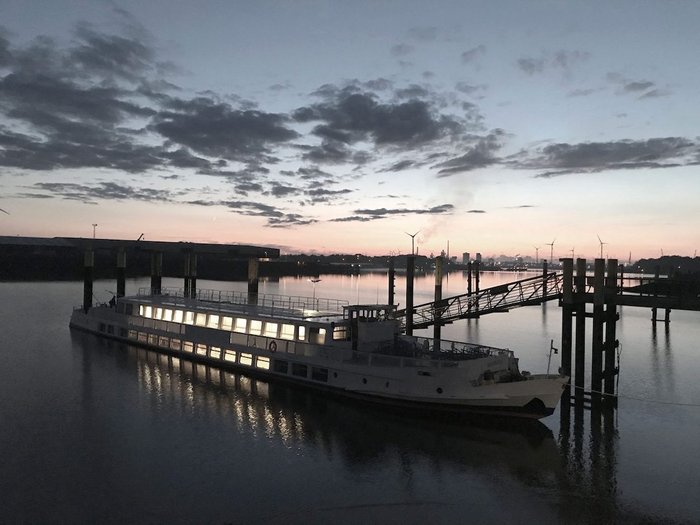 NewsThursday | 20 January 2022
NewsThursday | 20 January 2022MS „Dauerwelle“: Kunstraum in Bewegung
Die Hochschule für Künste Bremen eröffnet ein umgestaltetes Passagierschiff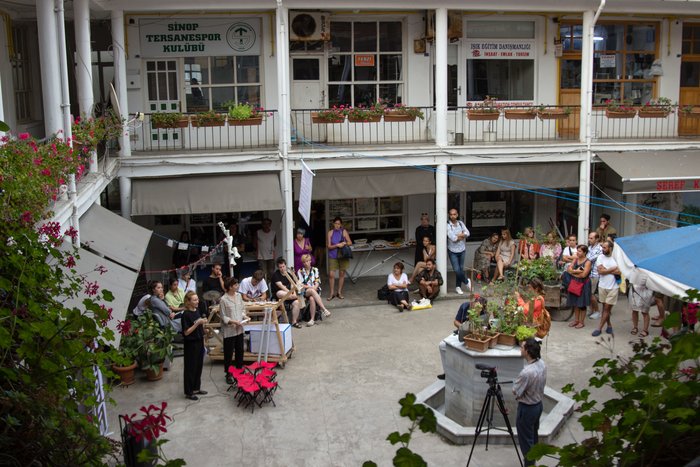 NewsTuesday | 23 July 2019
NewsTuesday | 23 July 2019Live bei der „Sinopale 7“ (16.8.–6.9.)
Eindrücke von der kooperativen Biennale im nordtürkischen Sinop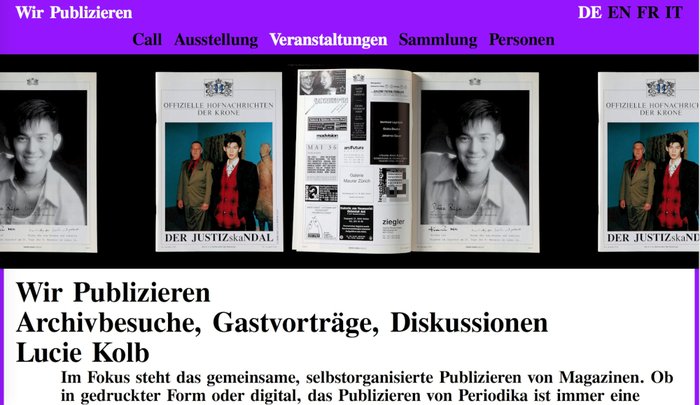 NewsWednesday | 6 February 2019
NewsWednesday | 6 February 2019„Wir publizieren“ – Master-Studio School of Visual Combinations
Projekt des Fachbereichs KuD der HfK mit der HKB zum Herausgeben, Vervielfältigen und Verteilen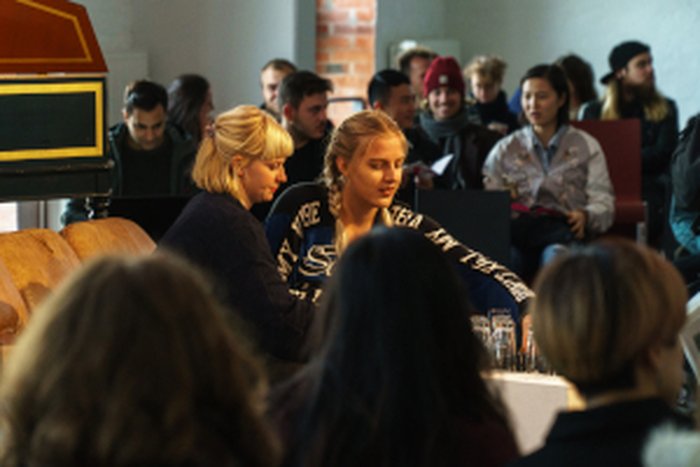 ReviewWednesday | 10 October 2018
ReviewWednesday | 10 October 2018Feierliche Semestereröffnung
225 Erstsemester starten in das Wintersemester

